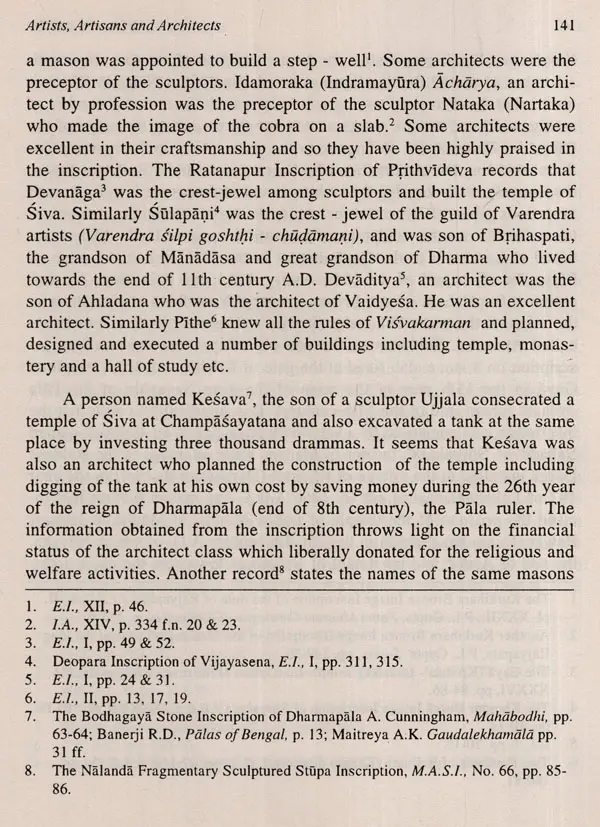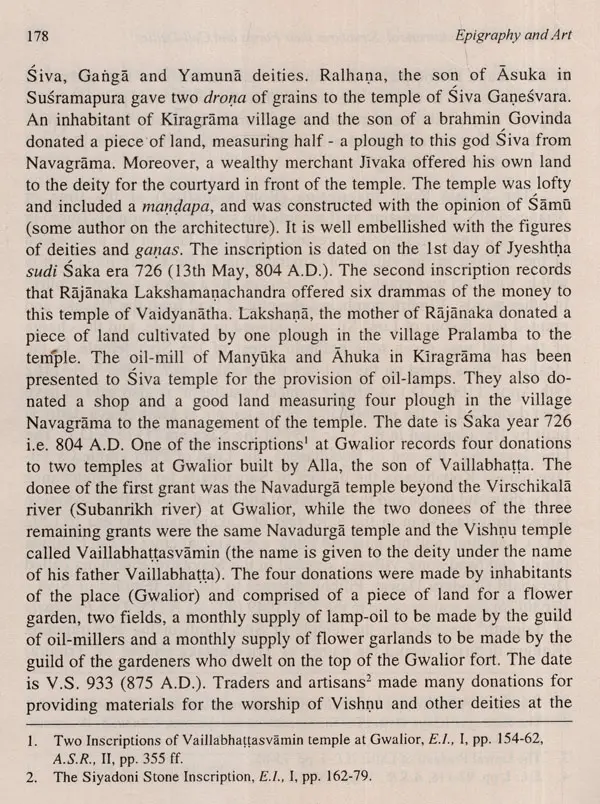
Epigraphy and Art (An Old and Rare Book)
Book Specification
| Item Code: | UAP171 |
| Author: | Seo Bahadur singh |
| Publisher: | Agam Kala Prakashan, Delhi |
| Language: | English |
| Edition: | 1996 |
| ISBN: | 8173200327 |
| Pages: | 227 (Throughout B/w Illustrations) |
| Cover: | HARDCOVER |
| Other Details | 10.00 X 7.50 inch |
| Weight | 620 gm |
Book Description
The first attempt of its kind unravelling the various facets of the Indian art gleaned in the epigraphs is an in-depth study based on the original sources. The present study encompasses the political strife, temple architecture, sculptural art, socio-economic condition, religion, patrons and donors. artists, artisans and architects and the management of architectural structures as reflected in the early-medieval period, the age of turmoil and transition.
The mostly informative, critical and comprehensive and immensely readable analysis bringing latest archaeological, epigraphic and literary insights bears a rich testimony to Dr. Singh's multifacted experience in the field of art and archaeology. A book of merit, it should prove to be useful to scholars interested in the art history.
Sheo Bahadur Singh earned his Master's degree (1955) and Ph.D (1968) in the Ancient Indian History and Archaeology from the Lucknow University He had a rewarding association spanning well for one and a half decade with the Archeological Survey of India. Since 1973, he was engaged in teaching post-graduate students and guiding research in the field in the Department of Ancient Indian History. Culture and Archaeology. Kurukshetra University and subsequently retired as Professor from the same Department in 1992 Moreover, he was accorded the Senior Research Fellowship by the Indian. Council of Historical Research and completed the present monograph Epigraphy and Art.
Professor Singh is a prolific writer Among his numerous publications including about sixty research papers in prestigious Journals like East and West (Rome). Arts of Asia (Hong Kong), Lalit Kala, Journal of the Indian Society of Oriental Art, Roopa-Lekha etc,, he is also the author of four books, The Archaeology of the Lucknow Region (1972) [collaboration]. Brahmanical Icons in Northern India. (1977, awarded a gold medal from the Lucknow University), Letters of Sir H.M. Lawrence (1978) and Archaeology of Panchala Region (1979). At present, he is busy in completing a University Grants Commission Project on the Early Medieval Sculptural Art in the Northern India.
The studies of Epigraphy and Art in a vast country like India cannot be pursued with any measure of exhaustiveness without reference to geographi cal regions and chronological limits. The regional study of the subject, a prerequisite to the determination of local stylistic trends in art on the basis of inscriptions, remains as yet a desideratum. In order to fulfil this obligation, the analysis of the available epigraphs (c.A.D. 700-1200) is modestly attempted for understanding their bearings on art in the North India with chronology, style, cult-deities, religious edifices and architectural structures. Patrons and donors, architects and artisans and maintenance and management. of architectural buildings are also taken into account on the basis of inscrip tions of the Northern India. Attempts have also been made to corroborate the facts gleaned from the literary and archaeological sources as well.
I take this opportunity to express my gratitude to the Indian Council of Historical Research, New Delhi for graciously granting me Fellowship for this project. I express my sincere thanks to Professor Irfan Habib, the ex chairman and Dr. Ravindra Kumar, the present Chairman of the L.C.H.R. Dr. B.K. Pandeya, the Dy. Director, I.C.H.R. rendered help in various ways for which I am thankful to him.
I am also thankful to Dr. Mahendra Singh Sodha, the previous Vice Chancellor, University of Lucknow for kindly permitting me to undertake the research work in the University. My thanks are also due to Professor S.P. Singh, the present Vice-Chancellor, Lucknow University for his research orientation. I am deeply beholden to Professor S.N. Chaturvedi for his generous help and valuable suggestions. I am also grateful to Shri M.C. Joshi, ex-D.G.A., Professor K.K. Thaplyal, Professor R. Awasthi, Professor S.N. Mishra, Dr. S.M. Mishra and other staff members of the Department of Ancient Indian History and Archaeology, University of Lucknow for the one or the other kinds of help rendered by them. My thanks are also due to Shri S.K. Shreevastava, Dy. Librarian and other staff members of the Tagore library (Lucknow University). Dr. S.D. Trivedi, Director, State Museum, Lucknow, and Dr. Rakesh Tewari, Director, U.P. State Archaeological Organisation, Lucknow. My grand-daughter Nidhi Singh has compared the typed-script for that I give her blessings. I am also very much thankful to Dr. Agam Prasad and Shri Rahul of Agam Kala Prakashan for publishing the monograph in such a short duration. The Author craves the indulgence of the readers for errors of omission and commission which might have escaped notices due to my limitations.
Inscriptions are important source material for the chronological re construction of the Indian History mainly in the political, socio-eco nomic, religio-cultural and linguistic fields since the 3rd century B.C. or a bit earlier. They also furnish valuable evidence for the reconstruction of the evolution of the art period-wise by giving dates. Inscriptions are engraved on various materials, such as on rock boulders, stone-slabs, stone or iron pillars, copper plates and plates of gold, silver, iron, zinc and bronze, along with inscribed wood, brick, leather and cloth etc. The nature of these inscriptions is manifold, such as political achievements.commercial transactions, deeds of sale of land or endow ments, cess or revenue, legal transactions, trade, construction or renova tion of temples, lakes, tanks, wells, cisterns and images, label inscrip tions recording names of pilgrims, sculptors, stone masons and patrons or donating or commemorative epigraphs etc. Some inscriptions are purely of religious nature, or on the code of conduct, ethics and morality. Thus, epigraphs are very reliable source material for the reconstruction of the Indian history in its various spheres.
The endeavour has revealed the remarkable data regarding the art studies with the dates of construction, consecration or renovation of temples, images, water works and other secular buildings which are utmost important as chronological sequence in the reconstruction of his torical cum stylistic phases of the evolution and decline of the differ ent schools of the Indian art. The epigraphs also disclose the names of patrons - kings, queens, courtiers, feudatories, merchants, rich and noble persons, religious preceptors and even common folk who were respon sible for the construction of temples and other edifices, names of archi tects, sculptors, artisans and skilled and semi skilled craftsmen who had constructed various buildings and created art objects. These further disclose that the people from various sections of the society were in spired to erect shrines of their choice either at sacred places or at the places where they resided. Moreover, these inform that the purpose of the temple construction was mainly twofold the spiritual elevation of the patron as well as the gain of the material prosperity.
The inscriptions have given extensive data on the location and dates of the art objects and architectural edifices. These have furnished a fair idea of the sites where the temple or secular buildings were constructed by mentioning the names of places, or conspicuously by the find - spots of these epigraphs. Likewise, these inscriptions have also provided dates of erection, consecration or repairs of shrines or other buildings, dates of installation, consecration or renovation of images, dates of construction or repairs of parts of temples, such as mandapas, präkara walls, front walls and temple - tanks etc., dates of construction of subsidiary shrines and dates of construction of cisterns, tanks, wells and other water - works. These chronological dates are significant as without them our knowledge of the evolution of the stylistic phases of the art would be incomplete. The inscriptions also furnish useful information on the temple forms with architectural terms current in those days in the Sanskrit as well as colloquial languages which are helpful in denoting their classifi cation. This knowledge is useful in understanding the genesis, concept, form, style and architectural components of shrines erected during the early medieval period. Some new names of deities have been found in the course of epigraphical studies which can be visualised, either the local deities or the various iconographic forms of the gods current in those days with their underlying concept. Occasionally, donors are named after their deities or vice versa, as a mark of deep respect and devotion to their loving gods.
Book's Contents and Sample Pages

















